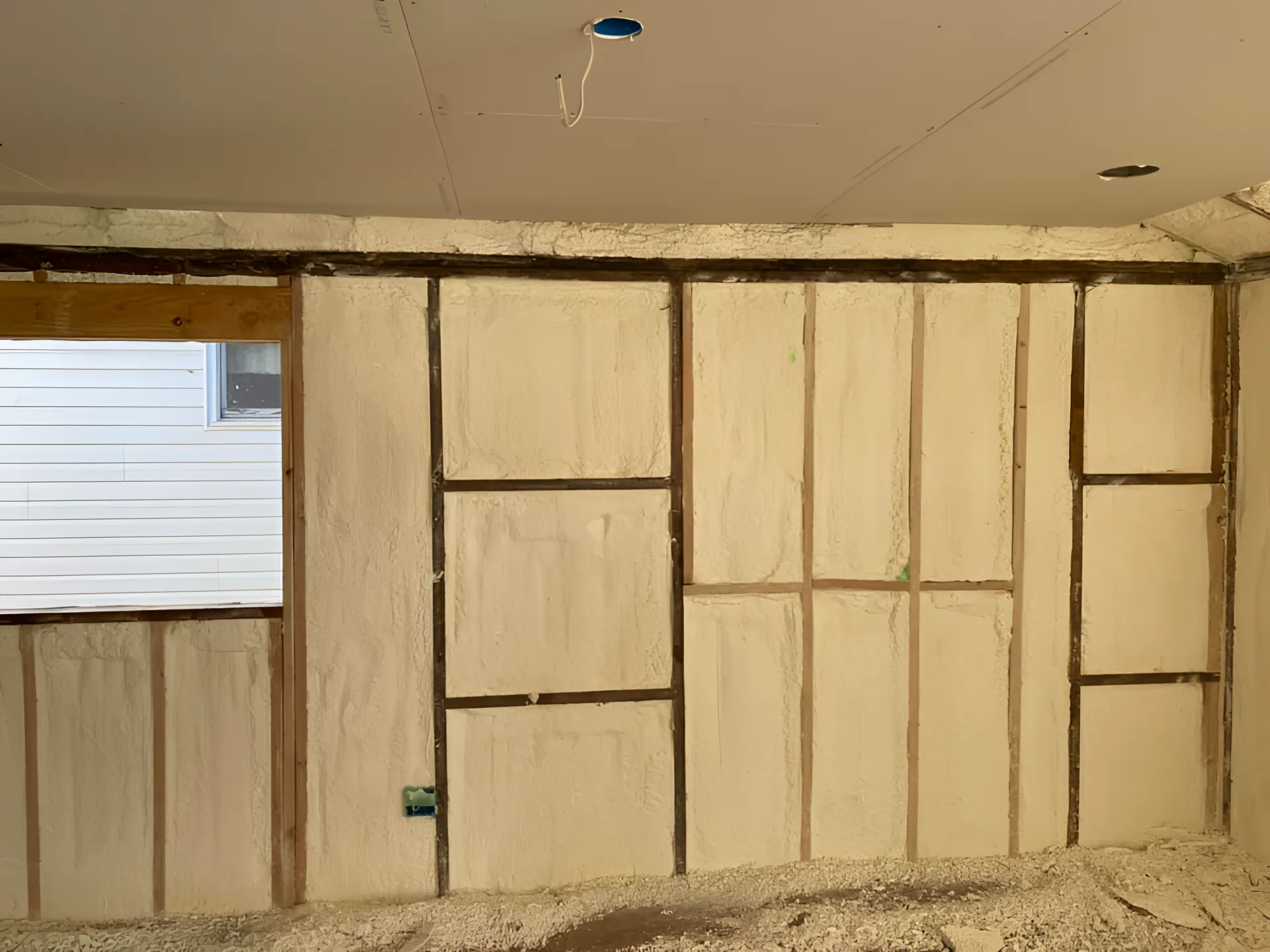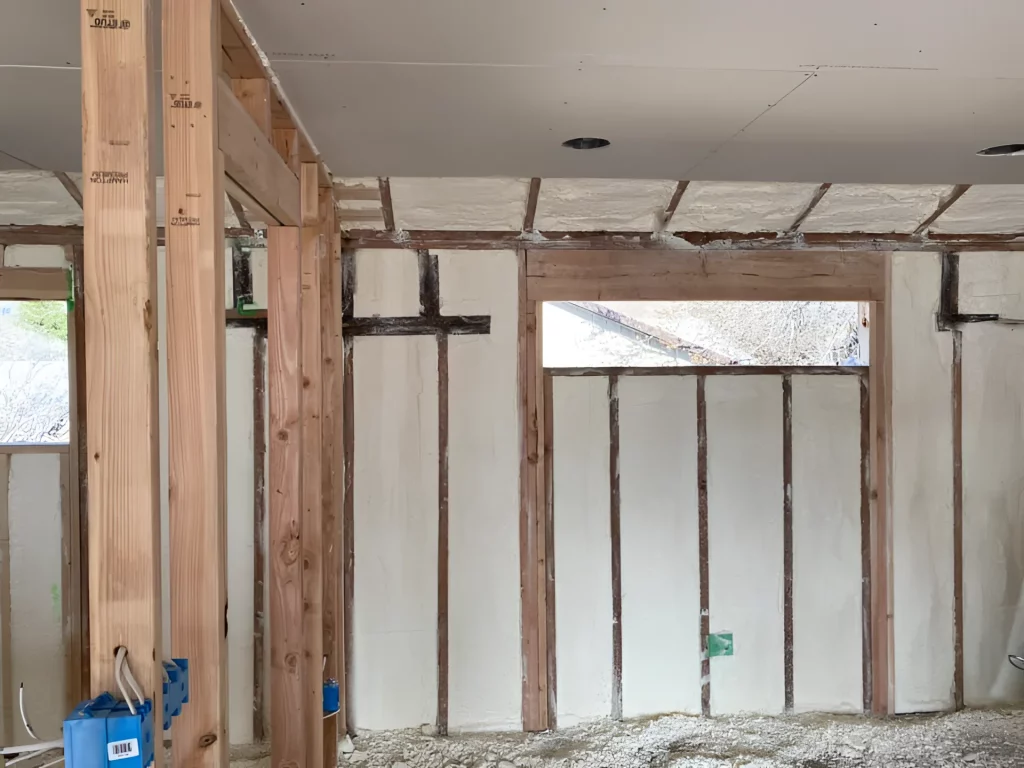
Spray foam insulation is a highly effective method for preventing pipes from freezing. It works by creating a complete, airtight seal around the plumbing, which stops cold air from reaching the pipe’s surface. Unlike other insulation types that can leave gaps, spray foam expands to fill every crack and void, forming a continuous thermal barrier. This barrier, combined with its high resistance to heat transfer (R-value), keeps the water inside the pipes at a temperature above freezing, even when the surrounding air is extremely cold.
The consequences of a burst pipe go far beyond a simple plumbing repair. A single pipe burst can release gallons of water per minute, leading to significant structural damage, ruined belongings, and potential mold growth. This article explains the mechanics of how spray foam insulation offers a permanent solution to this winter threat. Drawing on years of field experience managing insulation projects in cold climates, High Country Solutions has prepared this guide to detail how this technology works and what property owners should know.
Pipes don’t burst because ice expands outward, but because of the immense pressure that builds between the ice blockage and the closed faucet. When water freezes, it expands by about 9%, according to information from the University of Illinois Extension. This expansion creates a plug of ice inside the pipe. As more water freezes, it pushes the trapped liquid water toward the closed end of the pipe, generating pressure that can exceed 2,000 pounds per square inch (PSI), which is more than enough to rupture steel, iron, or copper pipes.
Pipes located in unconditioned or poorly insulated areas are the most vulnerable, including those in:
Effective insulation is the primary defense against this pressure build-up by keeping the pipe wall and the water inside it from reaching 32°F (0°C).
Spray Polyurethane Foam (SPF) is applied as a two-part liquid that mixes at the tip of a spray gun. When it hits a surface, it undergoes a chemical reaction, expanding up to 60 times its liquid volume before hardening into a solid foam. This process is key to its effectiveness.
There are two main types of spray foam, but one is clearly better for protecting pipes.
This is the recommended type for pipe insulation. It is dense, rigid, and has a high R-value, typically between R-6 and R-7 per inch. Its cellular structure is filled with a gas that makes it a poor conductor of heat. Critically, closed-cell foam is also a vapor barrier, meaning it repels moisture. This is extremely important in damp areas like crawl spaces, as it prevents condensation from forming on the pipes, which could lead to corrosion or mold.
Open-cell foam is lighter, more flexible, and has a lower R-value (around R-3.5 per inch). Its cells are not fully closed, allowing it to absorb and hold water, much like a sponge. While it’s an excellent air barrier for other applications like sound dampening, its water-absorbent properties make it unsuitable for protecting pipes in potentially damp environments.
Not all insulation performs equally when it comes to the unique challenges of protecting pipes. The right choice depends on creating a complete and durable thermal and air barrier.
| Feature | Closed-Cell Spray Foam | Fiberglass Batts | Foam Pipe Sleeves |
|---|---|---|---|
| R-Value per Inch | 6.0 – 7.0 | 3.1 – 3.4 | 3.0 – 4.0 |
| Air Sealing | Excellent (monolithic seal) | Poor (leaves gaps and seams) | Fair (seams must be taped) |
| Moisture Resistance | Excellent (acts as a vapor barrier) | Poor (loses R-value when wet) | Good |
| Application | Professional installation required | DIY-friendly | DIY-friendly |
Bonus Tip: For pipes in extremely cold but dry locations like an attic, combining foam pipe sleeves with a complete layer of spray foam over the top can offer redundant protection. However, in most cases, properly applied closed-cell foam alone is sufficient.

Applying spray foam is a permanent solution, so a few factors need to be weighed before installation.
Bonus Tip: When insulating pipes in a crawl space, ensure the application includes the rim joists. This is a major source of cold air infiltration and sealing it improves the overall thermal performance of the space, not just the pipes.
Protecting pipes from freezing is about more than just wrapping them in insulation; it requires creating a complete air and thermal seal. Spray foam accomplishes this by forming a seamless, moisture-resistant barrier that other materials cannot match. It directly addresses the air leakage that is often the primary cause of frozen pipes in basements, crawl spaces, and exterior walls.
Before winter arrives, it’s wise to evaluate your property’s vulnerable areas. Consider the long-term reliability and effectiveness of spray foam as a permanent solution to prevent the costly damage a burst pipe can cause.
For homeowners and property managers looking for a definitive solution to protect their plumbing from cold weather, a professional evaluation is the best next step. To discuss the specific needs of your property, contact High Country Solutions for a detailed consultation at (307) 248-9063 or send an email to [email protected].
Closed-cell spray foam acts as a vapor barrier, which stops warm, moist air from reaching the cold surface of the pipe. This prevents condensation from forming in the first place, protecting pipes from moisture-related issues like corrosion and mold.
Reputable spray foam products contain flame retardants and are tested to meet building code requirements for fire safety, such as the ASTM E84 standard. When installed correctly, they do not pose a fire risk.
The heat generated during the curing process is minimal and dissipates quickly. It will not damage standard plumbing materials. The expansion pressure is also not strong enough to crush or deform pipes.
When applied correctly and not exposed to direct sunlight (UV radiation), spray foam insulation is inert and stable. It does not sag, settle, or decompose over time and should last for the life of the building.
Absolutely. Insulating hot water pipes with closed-cell spray foam reduces heat loss as the water travels from the water heater to the faucet. This means the water arrives hotter, and your water heater works less, saving energy.